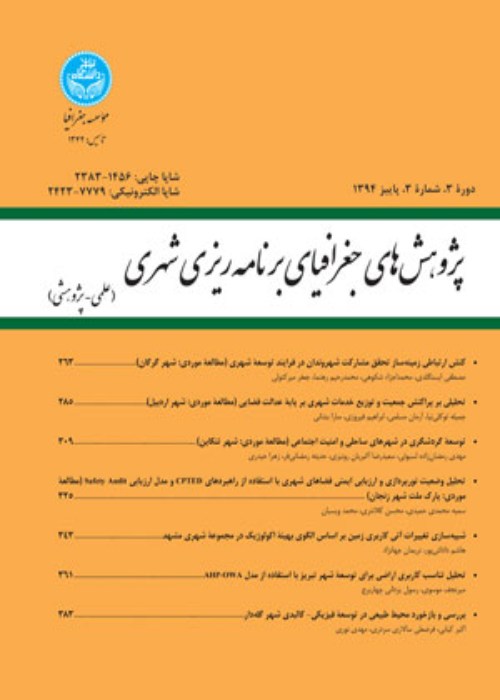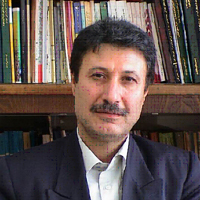Explaining the relationship between social capital and the vitality of urban neighborhoods, Case Study: Ahwaz City
AbstractStrengthening the vitality of urban neighborhoods as the smallest unit of urban management and the geographical center of the formation of local communities is the foundation of a vibrant, dynamic and pioneer city. One of the factors affecting the vitality of urban neighborhoods is social factor, and in various researches the effect of this notion on urban spaces development, social sustainability, local sustainable development, satisfaction of residents and local management has been investigated. Though the effect of social capital and its constructive components on the vitality of urban neighborhoods have been chosen as the main objective of the present study. The research methodology was descriptive-analytical and was practical in the terms of purpose. To this end, in a survey method, 392 questionnaires were completed in Bagh-e-Sheikh and KianAbad neighborhoods of Ahwaz city, and the obtained results were analyzed using one sample t-test and independent t-test in SPSS software and structural equation modeling in Amos graphic software. The results showed that the respondents evaluated the components of social capital (social trust, social participation, social cohesion and social relations) in the studied areas significantly higher than the average, and the amount of the mentioned components had no significant difference in the two mentioned neighborhood. In evaluating the designed structural equation, the value of the indices confirms the fitting of the mentioned equation, hence; the conceptual model of the research was acceptable and the positive and significant impact of the social capital on the vitality of the urban neighborhoods was confirmed. The largest contribution in explaining the social capital structure was related to the social participation, and in case of vitality, it was related to the availability and mobility componentsExtended AbstractIntroductionVitality is one of the qualities of urban spaces that the most important of which is the self-evident presence of citizens in public spaces and the shaping of the vital force of the place. In fact, the vitality or active and passionate presence of people in urban spaces is one of the important and positive characteristics of such spaces that neglecting them causes urban spaces to lose their social function and appear cold and lifeless. Enhancing the vitality of urban neighborhoods as the smallest unit of urban management and the geographical focus of the formation of local communities is the infrastructure of the creation of a vibrant, dynamic and progressive city. Some of the effective factors on the vitality of urban neighborhoods is social factors and in various studies the impact of them on urban spaces development, social sustainability, local sustainable development, residents' satisfaction and local management has been investigated. In this study, however, the impact of social capital and its components on the vitality of urban neighborhoods has been selected as the main objective of the present study and the it seeks to answer the following questions: Do the components of social capital and vitality differ significantly in the studied neighborhoods? How is the impact of social capital on the formation of vitality in neighborhoods?According to the research objectives and questions, the accuracy of the following hypotheses in the study was investigated:- Social capital has a positive and significant impact on neighborhood vitality.- The studied neighborhoods have significant differences in terms of social capital components.- Kianabad neighborhood is significantly more vibrant than Bagh-e-Sheikh neighborhood. MethodologyThe method of this study is analytical quantitative and after library studies the data were collected through questionnaire. To select the sample, two neighborhoods of Ahvaz were selected by clustering method and questionnaires were distributed among the analysis units (households) according to the population of the neighborhoods. The sample size was estimated to be 384 using the Cochran formula according to the sample population that in order to complete not less than 100 questionnaires in each neighborhood, a total of 400 questionnaires were completed by systematically classified method. After refining the completed questionnaires, totally the information of 392 questionnaires including 101 questionnaires in Bagh-e-Sheikh neighborhood and 291 questionnaires in Kianabad neighborhood were analyzed. Data were analyzed by descriptive and inferential statistics including univariate and independent t-tests in SPSS software and structural equation modeling using Amos Graphic software. Results and discussionThe results showed that, contrary to the third hypothesis, residents' evaluation of the vitality of Bagh-e-Sheikh neighborhood is higher that factors such as neighborhood safety, more use at night, convenient access to nearby locations, and meeting needs through downtown has had a significant impact on this issue. However, it should be noted that the evaluation of vitality in this study was not based on objective factors and residents' evaluation of the components of vitality included presence, attractiveness and satisfaction which is certainly influenced by variables such as rooting and attachment to residence, the case that has not been investigated. Although the mean of the components of vitality was evaluated higher than the average from the viewpoints of residents (and the difference is statistically significant), the score of the attractiveness of the component was lower than the assumed average and the weakness of the studied sample are evident in terms of the presence of meeting spaces and hangouts, the possibility of walking, the presence of traditional and modern markets, and the amusement facilities in the neighborhoods. Considering the social capital with regard to the characteristics and antiquity of Bagh-e-Sheikh neighborhood, it was expected that the stronger social capital would be achieved in this neighborhood. The results show that although the social capital of Bagh-e-Sheikh neighborhood is slightly higher than Kianabad and there is more standard deviation in Kianabad neighborhood, there is no significant difference in social capital and its components in studied neighborhoods. Intervention and the impact of downtown commercial context (adjoining dense context and transferring its traffic passing), population displacement caused by burnout and slow renovation and also the conversion of large-scale neighborhoods into cellar and deserted neighborhoods may be the reason for the decline of the social capital in the neighborhood that has made its social capital not significantly different from the relatively modern Kianabad neighborhood. In Bagh-e-Sheikh neighborhood, the participation and the social cohesion were higher and the social trust was the lowest component, and in particular, institutional trust items in this neighborhood have been evaluated weak as indicating dissatisfaction with the performance of urban managers and the inefficiency of programs in this worn-out and old context of the town. In evaluating the designed structural equation, the value of the indices confirms the fit of the mentioned equation, so the conceptual model of the research is acceptable and the positive and significant impact of the social capital on the vitality of urban neighborhoods is confirmed. The greatest contribution to explaining the structure of the social capital is related to social participation and is case of the vitality is related to the component of presence and mobility. ConclusionThe results show that the respondents evaluated the social capital components (social trust, social participation, social cohesion, and social relations) as significantly higher than the mean in the studied neighborhoods, and the value of the mentioned components was not significantly different in the two studied neighborhoods. Investigating the structural equation of research shows that the stronger the social capital and its components in urban neighborhoods, the more likely to have a vibrant neighborhood. This issue demonstrates the importance of neighborhood social actions in line of enhancing the presence of people in public spaces. Neighborhood social relations are formed in the context of public spaces. The impact of social capital on the development and quality of this space has also been confirmed in previous studies. For example, Rezazadeh et al. (1392) have examined the role of the social capitals in addition to the physical capital in local sustainable development in the investigation of the asset-based approach to the local sustainable development, in which vitality, dynamism, adaptation and diversity considered the principles of the local sustainability and they have endorsed the relationship between the social capitals and the sustainable local development. Consequently, the results of this study are in line with the above research. According to the results of the study, it is recommended that in order to enhance the vitality of the studied neighborhoods, the policy making to enhance participation (the most influential component of the social capital formation) and social trust (the weakest component of social capital in the studied neighborhoods) should be implemented through mechanisms related to various areas of urban management and socio-cultural management to enhance the vitality of neighborhoods through social capital as well.
- حق عضویت دریافتی صرف حمایت از نشریات عضو و نگهداری، تکمیل و توسعه مگیران میشود.
- پرداخت حق اشتراک و دانلود مقالات اجازه بازنشر آن در سایر رسانههای چاپی و دیجیتال را به کاربر نمیدهد.





